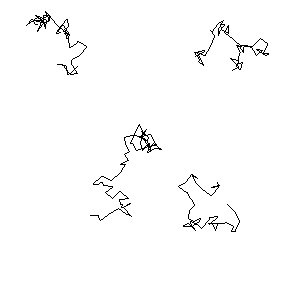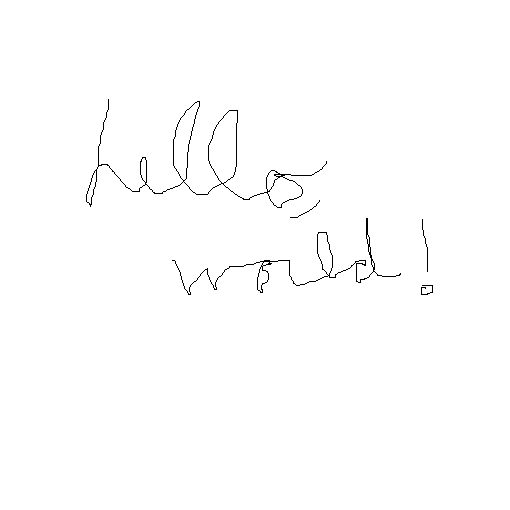Objectives
- To introduce digital animation
- To introduce human-computer interaction
Digital Animation
Processing supports digital animation of geometric figures such
the following:
|
This program models the semi-random movement of an object in 2D
space using Brownian
motion . You can animate
this behavior by setting a fixed starting point and then repeatedly
varying the x and the y coordinates by a small, random amount. . You can animate
this behavior by setting a fixed starting point and then repeatedly
varying the x and the y coordinates by a small, random amount.
You can run the animation by clicking on the animation image to
the right. You must have the Java runtime environment (JRE) installed
for this to work and you may need to enter the course materials
password.
|
 |
Exercise 4a.1:
Write an animation program whose output is like the one shown
above. Start your scribble in the middle of the output pane and move it
a short random distance away from its current position on each
successive frame. Ensure that it never leaves the visible part of the
canvas shown in the output pane.
To implement the animation, you can follow an algorithm such as
this one:
- Data: x & y coordinates (float)
- Setup:
- Set the output panel size.
- Initialize x & y to the center of the output panel.
- Draw:
- Set
newX and newY equal to new x-y
coordinate values that are a small random distance away from where x
and y were in the previous frame (Note that you can use
the random
method to compute a
small random number around 0 and the constrain
method
to compute a
small random number around 0 and the constrain
method to ensure that
the new coordinates are on the visible output pane);
to ensure that
the new coordinates are on the visible output pane);
- Draw a line from the previous coordinates (
x, y)
to the new coordinates (newX, newY);
- Set the old coordinates (
x, y)
equal to the new coordinates (newX, newY) -
this ensures that the new coordinate values will be saved and used as
the starting point in the next iteration.
Note that in this algorithm the scope of the coordinates (x,
y) is global to the whole program while the scope of (newX,
newY) is local to the draw() method. When you
have your program running, take a moment to ask yourself these
questions: Could we make x and y local to draw()?
Would the animation still run? Could we make newX and newY
global? Would it be good idea to do it that way?
Human-Computer Interaction
Processing also supports mouse-based interaction between the user
and the program.
Exercise 4a.2:
|
Modify your program from the previous exercise so that it
re-sets the random scribbling to the location specified by the mouse
click. Your program should produce output that looks something like
the one shown on the right.
You can implement this by adding a mousePressed()
method to your current prototype that changes the saved (x,
y) coordinates to the coordinates of the most recent
mouse press (stored automatically by Processing in the mouseX
and mouseY variables).
Save this version of your program so that you can turn it in
later.
|
 |
Although Processing requires that the draw() method
be defined for all animation programs, it doesn’t require that
that method contain code. It could be defined to do nothing:
void draw() { }
This can be used in programs that respond to user initiated
events only and not to a pre-defined frame rate.
Exercise 4a.3:
|
Modify your program from the previous exercise so that it
becomes an interactive program that allows the user to scribble
manually. Your program should allow the user to create output that
looks something the one shown on the right by pressing and dragging
the mouse around on the output pane.
You can implement this by removing the code from the draw()
and mousePressed() methods in the previous exercise
writing a new mouseDragged() method that draws a line
from the previous mouse location (pmouseX, pmouseY)
to the current mouse location (mouseX, mouseY).
Note that with this implementation, your program no longer needs to
store the previous mouse position because Processing already stores
the previous location of the mouse.
Save this version of your program so that you can turn it in
later.
|
 |
Processing applications can also respond to key-pressing events.
Exercise 4a.4:
Modify your program from the previous exercise so that when the
user presses any key on the keyboard, the program dumps the current
image to a JPG image file. You can implement this by adding a keyPressed()
method that calls the save()
method. Save the image using a hard-coded filename each time. Be sure
that you can find the image file that Processing dumps.
Save this version of your program so that you can turn it in
later.
Checking In
Submit all the code and supporting files for the exercises in
this lab.
 . You can animate
this behavior by setting a fixed starting point and then repeatedly
varying the x and the y coordinates by a small, random amount.
. You can animate
this behavior by setting a fixed starting point and then repeatedly
varying the x and the y coordinates by a small, random amount.


